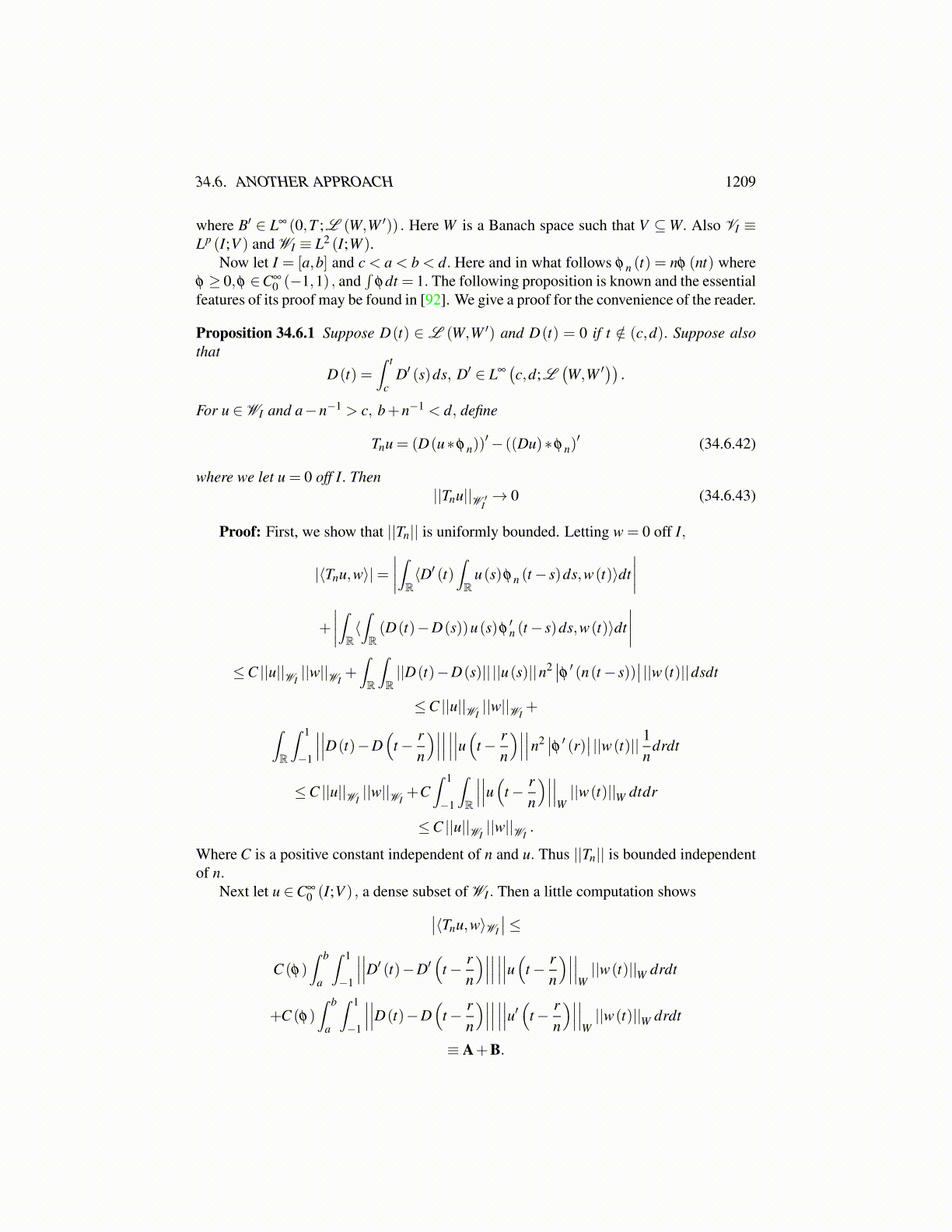
34.6. ANOTHER APPROACH 1209
where B′ ∈ L∞ (0,T ;L (W,W ′)) . Here W is a Banach space such that V ⊆W. Also VI ≡Lp (I;V ) and WI ≡ L2 (I;W ).
Now let I = [a,b] and c < a < b < d. Here and in what follows φ n (t) = nφ (nt) whereφ ≥ 0,φ ∈C∞
0 (−1,1) , and∫
φdt = 1. The following proposition is known and the essentialfeatures of its proof may be found in [92]. We give a proof for the convenience of the reader.
Proposition 34.6.1 Suppose D(t) ∈ L (W,W ′) and D(t) = 0 if t /∈ (c,d). Suppose alsothat
D(t) =∫ t
cD′ (s)ds, D′ ∈ L∞
(c,d;L
(W,W ′
)).
For u ∈WI and a−n−1 > c, b+n−1 < d, define
Tnu = (D(u∗φ n))′− ((Du)∗φ n)
′ (34.6.42)
where we let u = 0 off I. Then||Tnu||W ′I → 0 (34.6.43)
Proof: First, we show that ||Tn|| is uniformly bounded. Letting w = 0 off I,
|⟨Tnu,w⟩|=∣∣∣∣∫R⟨D′ (t)
∫R
u(s)φ n (t− s)ds,w(t)⟩dt∣∣∣∣
+
∣∣∣∣∫R⟨∫R(D(t)−D(s))u(s)φ
′n (t− s)ds,w(t)⟩dt
∣∣∣∣≤C ||u||WI
||w||WI+∫R
∫R||D(t)−D(s)|| ||u(s)||n2 ∣∣φ ′ (n(t− s))
∣∣ ||w(t)||dsdt
≤C ||u||WI||w||WI
+∫R
∫ 1
−1
∣∣∣∣∣∣D(t)−D(
t− rn
)∣∣∣∣∣∣ ∣∣∣∣∣∣u(t− rn
)∣∣∣∣∣∣n2 ∣∣φ ′ (r)∣∣ ||w(t)|| 1n
drdt
≤C ||u||WI||w||WI
+C∫ 1
−1
∫R
∣∣∣∣∣∣u(t− rn
)∣∣∣∣∣∣W||w(t)||W dtdr
≤C ||u||WI||w||WI
.
Where C is a positive constant independent of n and u. Thus ||Tn|| is bounded independentof n.
Next let u ∈C∞0 (I;V ) , a dense subset of WI . Then a little computation shows∣∣⟨Tnu,w⟩WI
∣∣≤C (φ)
∫ b
a
∫ 1
−1
∣∣∣∣∣∣D′ (t)−D′(
t− rn
)∣∣∣∣∣∣ ∣∣∣∣∣∣u(t− rn
)∣∣∣∣∣∣W||w(t)||W drdt
+C (φ)∫ b
a
∫ 1
−1
∣∣∣∣∣∣D(t)−D(
t− rn
)∣∣∣∣∣∣ ∣∣∣∣∣∣u′(t− rn
)∣∣∣∣∣∣W||w(t)||W drdt
≡ A+B.